Dynamic Mechanical Response and Damage Mechanism of HTPB Propellant under Impact Loading
Abstract
:1. Introduction
2. Experimental Methodology
2.1. Material and Specimen Preparation
2.2. Dynamic Compressive Mechanical Testing
3. Results and Discussion
3.1. Dynamic Stress–Strain Characteristics and Fracture Behavior
3.2. Strain-Rate Dependence on the Dynamic Mechanical Response
4. Conclusions
Author Contributions
Funding
Conflicts of Interest
References
- Kakavas, P. Mechanical properties of propellant composite materials reinforced with ammonium perchlorate particles. Int. J. Solids Struct. 2014, 51, 2019–2026. [Google Scholar] [CrossRef] [Green Version]
- De La Fuente, J.L.; Rodriguez, O. Dynamic mechanical study on the thermal aging of a hydroxyl-terminated polybutadiene-based energetic composite. J. Appl. Polym. Sci. 2003, 87, 2397–2405. [Google Scholar] [CrossRef]
- Verneker, V.P.; Kishore, K. Combustion and thermal decomposition characteristics of composite solid propellan. Thermochim. Acta 1976, 17, 73–83. [Google Scholar] [CrossRef]
- Schöyer, H.F.R.; Korting, P.A.O.G. Low Pressure Combustion of Composite Propellant. Propellants Explos. Pyrotech. 1984, 9, 149–156. [Google Scholar] [CrossRef]
- Yıldırım, H.; Özüpek, Ş.; Yıldırım, H. Structural assessment of a solid propellant rocket motor: Effects of aging and damage. Aerosp. Sci. Technol. 2011, 15, 635–641. [Google Scholar] [CrossRef]
- Simon, A. Structural Assessment of Solid Propellant Grains; AGARD-AR-350; University of Stellenbosch: Stellenbosch, South Africa, 1992. [Google Scholar]
- Zhuo, C.; Feng, F.; Wu, X.; Changfei, Z.; Xiaosong, W. Development process of muzzle flows including a gun-launched missile. Chin. J. Aeronaut. 2015, 28, 385–393. [Google Scholar] [CrossRef] [Green Version]
- Sui, X.; Wang, N.; Wan, Q.; Bi, S. Effects of Relaxed Modulus on the Structure Integrity of NEPE Propellant Grains during High Temperature Aging. Propellants Explos. Pyrotech. 2010, 35, 535–539. [Google Scholar] [CrossRef]
- Deng, B.; Xie, Y.; Tang, G.J. Three-dimensional Structural Analysis Approach for Aging Composite Solid Propellant Grains. Propellants Explos. Pyrotech. 2013, 39, 117–124. [Google Scholar] [CrossRef]
- Jeremic, R. Some Aspects of Time-Temperature Superposition Principle Applied for Predicting Mechanical Properties of Solid Rocket Propellants. Propellants Explos. Pyrotech. 2000, 24, 221. [Google Scholar] [CrossRef]
- O’Neil, P.T.; Heister, S.D. Evaluation of physical and ballistic properties of polymerized-icyclopentadiene-based composite solid propellants. J. Propul. Power 2014, 30, 749–759. [Google Scholar]
- Marimuthu, R.; Rao, B.N. Development of efficient finite elements for structural integrity analysis of solid rocket motor propellant grains. Int. J. Press. Vessels Pip. 2013, 111, 131–145. [Google Scholar] [CrossRef]
- Sikder, A.K.; Sikder, N. A review of advanced high performance, insensitive and thermally stable energetic materials emerging for military and space applications. J. Hazard. Mater. 2004, 112, 1–15. [Google Scholar] [CrossRef] [PubMed]
- Badgujar, D.M.; Talawar, M.; Asthana, S.; Mahulikar, P.P. Advances in science and technology of modern energetic materials: An overview. J. Hazard. Mater. 2008, 151, 289–305. [Google Scholar] [CrossRef] [PubMed]
- Herder, G.; Weterings, F.P.; De Klerk, W.P.C. Mechanical analysis on rocket propellants. J. Therm. Anal. Calorim 2003, 72, 921–929. [Google Scholar] [CrossRef]
- Ren, P.; Hou, X.; He, G.R.; Gao, J.; He, T.S. Comparative research of tensile and compressive modulus of composite solid propellant for solid rocket motor. J. Astronaut. 2010, 31, 2354. [Google Scholar]
- Yang, L.; Xie, K.; Pei, J.; Sui, X.; Wang, N. Compressive mechanical properties of HTPB propellant at low, intermediate, and high strain rates. J. Appl. Polym. Sci. 2016, 133, 1–9. [Google Scholar] [CrossRef]
- Yang, L.; Wang, N.; Xie, K.; Sui, X.; Li, S. Influence of strain rate on the compressive yield stress of CMDB propellant at low, intermediate and high strain rates. Polym. Test. 2016, 51, 49–57. [Google Scholar] [CrossRef]
- Sun, C.; Xu, J.; Chen, X.; Zheng, J.; Zheng, Y.; Wang, W. Strain rate and temperature dependence of the compressive behavior of a composite modified double-base propellant. Mech. Mater. 2015, 89, 35–46. [Google Scholar] [CrossRef]
- Chen, X.; Lai, J.; Chang, X.-L.; Zhang, Y.; Zhang, L.; Wang, C. Compressive mechanical properties of HTPB propellant at low temperatures and high strain rates. Results Phys. 2017, 7, 4079–4084. [Google Scholar] [CrossRef]
- Ho, S.Y.; Fong, C.W. Temperature dependence of high strain-rate impact fracture behaviour in highly filled polymeric composite and plasticized thermoplastic propellants. J. Mater. Sci. 1987, 22, 3023–3031. [Google Scholar] [CrossRef]
- Drodge, D.R.; Williamson, D.M. Understanding damage in polymer-bonded explosive composites. J. Mater. Sci. 2015, 51, 668–679. [Google Scholar] [CrossRef]
- Zhang, J.; Zheng, J.; Chen, X.; Sun, C.; Xu, J. A Thermovisco-Hyperelastic Constitutive Model of NEPE Propellant Over a Large Range of Strain Rates. J. Eng. Mater. Technol. 2014, 136, 031002. [Google Scholar] [CrossRef]
- Sunny, G.P. A High Strain-Rate Investigation of a Zr-Based Bulk Metallic Glass and a HTPB Polymer Composite. Ph.D. Thesis, Case Western Reserve University, Cleveland, OH, USA, 2011. [Google Scholar]
- Song, B.; Chen, W. Dynamic stress equilibration in split hopkinson pressure bar tests on soft materials. Exp. Mech. 2004, 44, 300–312. [Google Scholar] [CrossRef]
- Kolsky, H. An Investigation of the Mechanical Properties of Materials at very High Rates of Loading. Proc. Phys. Soc. Sect. B 1949, 62, 676–700. [Google Scholar] [CrossRef]
- Mulliken, A.; Boyce, M. Mechanics of the rate-dependent elastic–plastic deformation of glassy polymers from low to high strain rates. Int. J. Solids Struct. 2006, 43, 1331–1356. [Google Scholar] [CrossRef] [Green Version]
- Gensler, R.; Plummer, C.; Grein, C.; Kausch, H.-H. Influence of the loading rate on the fracture resistance of isotactic polypropylene and impact modified isotactic polypropylene. Polymer 2000, 41, 3809–3819. [Google Scholar] [CrossRef]
- Yang, J.; Zhang, Y.; Zhang, Y. Brittle–ductile transition of PP/POE blends in both impact and high speed tensile tests. Polymer 2003, 44, 5047–5052. [Google Scholar] [CrossRef]
- Koerber, H.; Camanho, P. High strain rate characterisation of unidirectional carbon–epoxy IM7-8552 in longitudinal compression. Compos. Part A Appl. Sci. Manuf. 2011, 42, 462–470. [Google Scholar] [CrossRef]
- Kurtz, S.M.; Pruitt, L.; Jewett, C.W.; Crawford, R.P.; Crane, D.J.; Edidin, A. The yielding, plastic flow, and fracture behavior of ultra-high molecular weight polyethylene used in total joint replacements. Biomaterials 1998, 19, 1989–2003. [Google Scholar] [CrossRef]
- Jiang, C.-L.; Cai, S.; Mao, L.; Wang, Z. Effect of Porosity on Dynamic Mechanical Properties and Impact Response Characteristics of High Aluminum Content PTFE/Al Energetic Materials. Materials 2019, 13, 140. [Google Scholar] [CrossRef] [Green Version]
- Chen, M.; Ren, C.; Liu, Y.; Yang, Y.; Wang, E.; Liang, X. Effects of Polypropylene Fibre and Strain Rate on Dynamic Compressive Behaviour of Concrete. Materials 2019, 12, 1797. [Google Scholar] [CrossRef] [PubMed] [Green Version]
- Kajberg, J.; Wikman, B. Viscoplastic parameter estimation by high strain-rate experiments and inverse modelling—Speckle measurements and high-speed photography. Int. J. Solids Struct. 2007, 44, 145–164. [Google Scholar] [CrossRef] [Green Version]
- Song, B.; Chen, W.; Liu, Z.; Erhan, S.Z. Compressive properties of soybean oil-based polymers at quasi-static and dynamic strain rates. J. Appl. Polym. Sci. 2005, 99, 2759–2770. [Google Scholar] [CrossRef]
- Fan, J.; Weerheijm, J.; Sluys, B. Compressive response of multiple-particles-polymer systems at various strain rates. Polymer 2016, 91, 62–73. [Google Scholar] [CrossRef]
- Field, J.E.; Walley, S.M.; Proud, W.G.; Goldrein, H.T.; Siviour, C.R. Review of experimental techniques for high rate deformation and shock studies. Int. J. Impact Eng. 2004, 30, 725–775. [Google Scholar] [CrossRef]
- Kariem, M.A.; Beynon, J.; Ruan, D. Misalignment effect in the split Hopkinson pressure bar technique. Int. J. Impact Eng. 2012, 47, 60–70. [Google Scholar] [CrossRef]
- Lifshitz, J.; Leber, H. Data processing in the split Hopkinson pressure bar tests. Int. J. Impact Eng. 1994, 15, 723–733. [Google Scholar] [CrossRef]
- Li, T.; Zhang, C.; Xie, Z.; Xu, J.; Guo, B.-H. A multi-scale investigation on effects of hydrogen bonding on micro-structure and macro-properties in a polyurea. Polymer 2018, 145, 261–271. [Google Scholar] [CrossRef]
- Miao, Y.; Zhang, H.; He, H.; Deng, Q. Mechanical behaviors and equivalent configuration of a polyurea under wide strain rate range. Compos. Struct. 2019, 222, 110923. [Google Scholar] [CrossRef]
- Singh, R.P.; Zhang, M.; Chan, D. Toughening of a brittle thermosetting polymer: Effects of reinforcement particle size and volume fraction. J. Mater. Sci. 2002, 37, 781–788. [Google Scholar] [CrossRef]
- Juhász, J. Mechanical properties of glass-ceramic A–W-polyethylene composites: Effect of filler content and particle size. Biomaterials 2004, 25, 949–955. [Google Scholar] [CrossRef]
- Miao, Y.G.; Du, B.; Ma, C.B.; Hu, H.T.; Deng, Q. Some fundamental problems concerned with the measurement accuracy of the Hopkinson tension bar technique. Meas. Sci. Tech. 2019, 30, 05009-18. [Google Scholar] [CrossRef]
- Kushvaha, V.; Tippur, H. Effect of filler shape, volume fraction and loading rate on dynamic fracture behavior of glass-filled epoxy. Compos. Part B Eng. 2014, 64, 126–137. [Google Scholar] [CrossRef]
- Backofen, W.A.; Turner, I.R.; Avery, D.H. Superplasticity. JOM J. Metals. 1964, 16, 763–772. [Google Scholar]
- Goble, D.L.; Wolff, E.G. Strain-rate sensitivity index of thermoplastics. J. Mater. Sci. 1993, 28, 5986–5994. [Google Scholar] [CrossRef]
- Park, C.; Huh, H.; Park, J. Rate-dependent hardening model for polymer-bonded explosives with an HTPB polymer matrix considering a wide range of strain rates. J. Compos. Mater. 2014, 49, 425–438. [Google Scholar] [CrossRef]

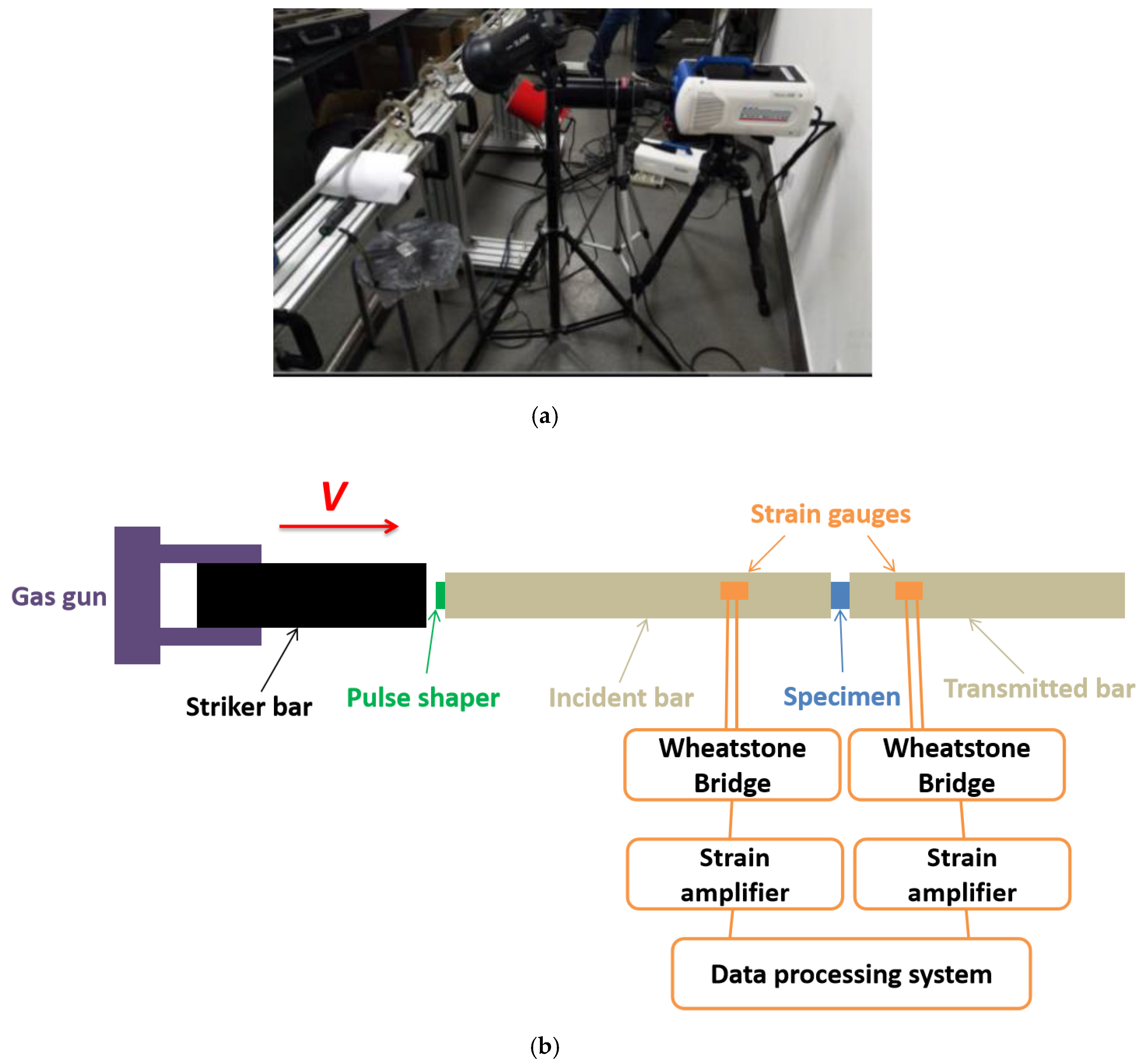
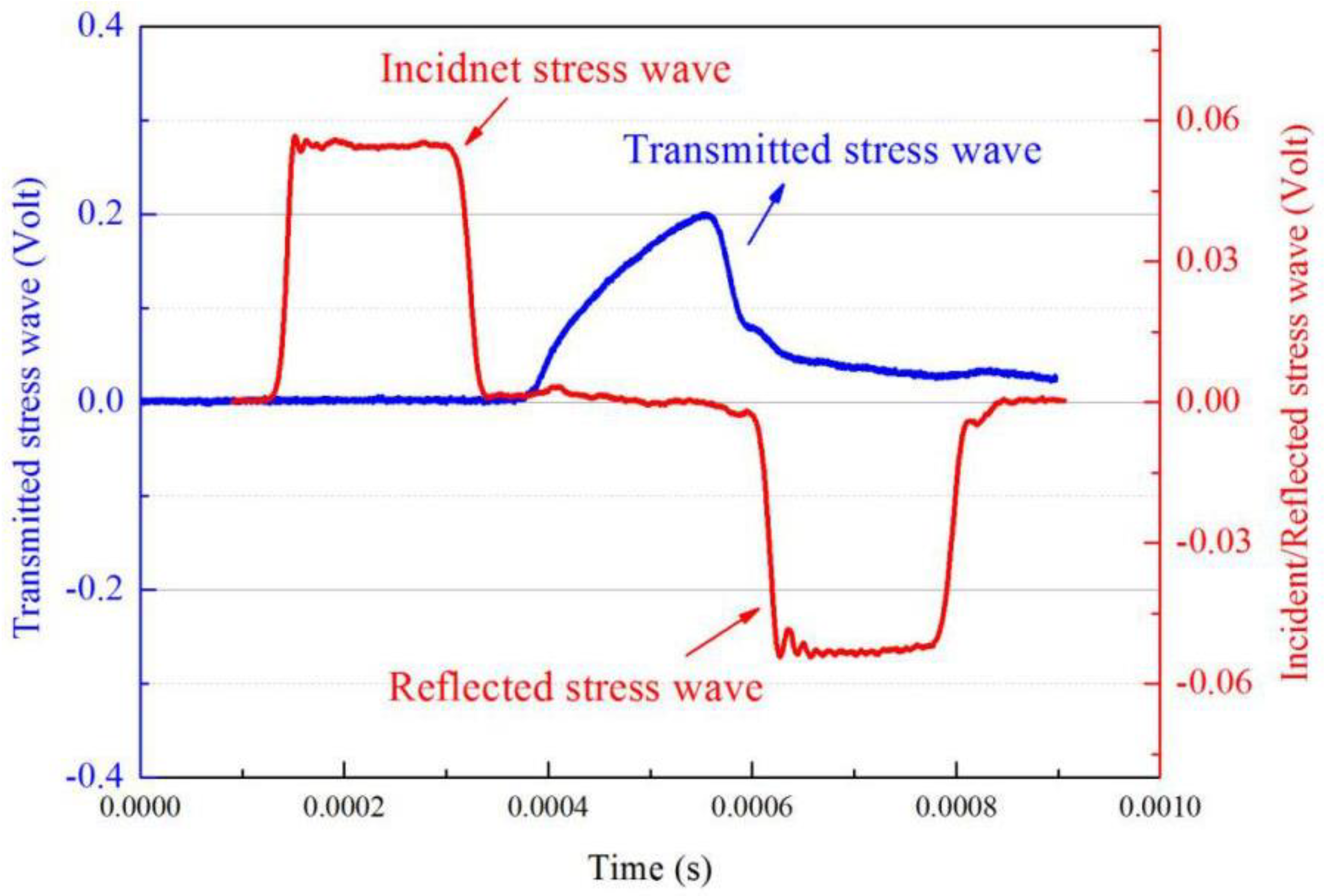
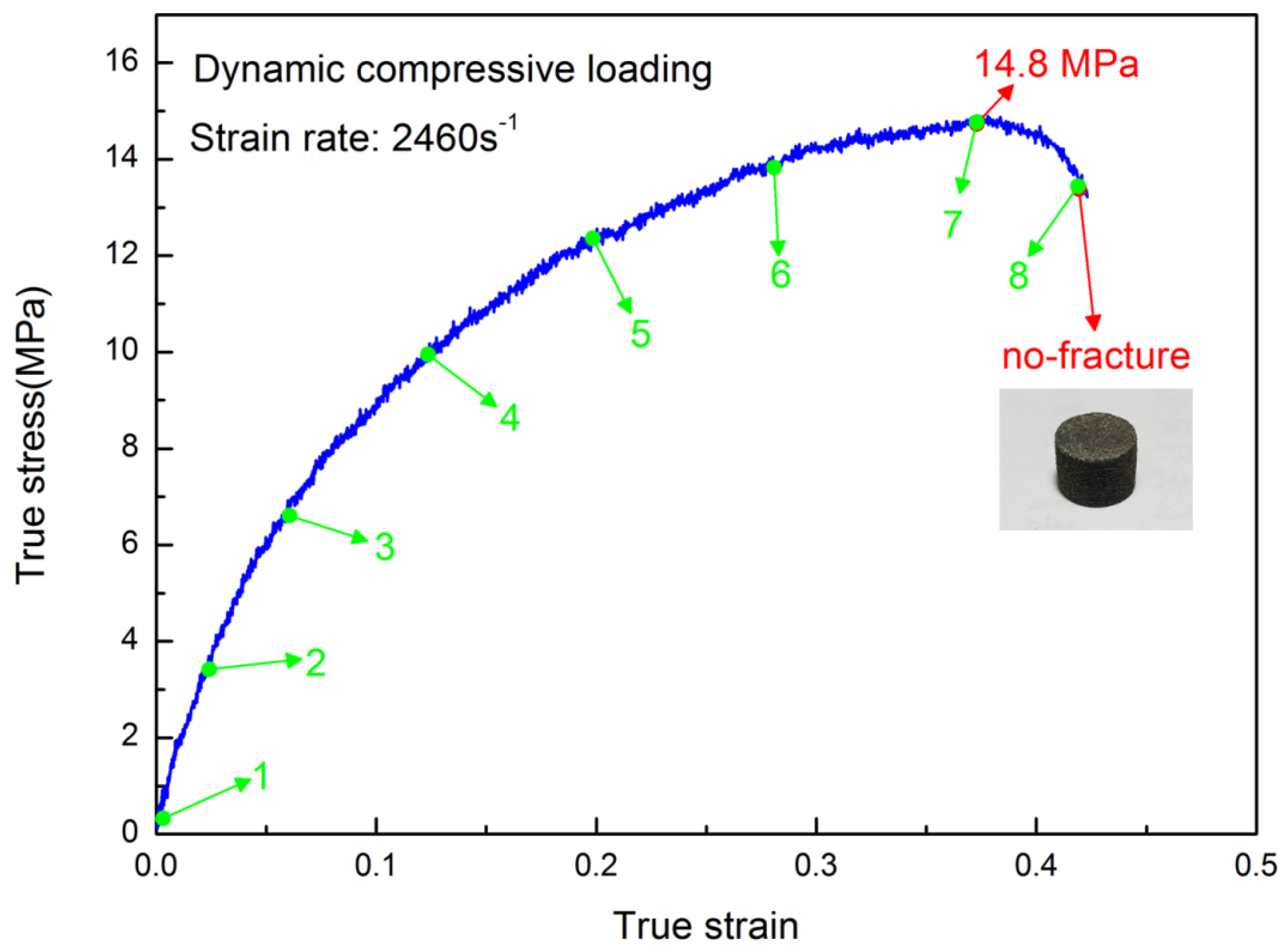
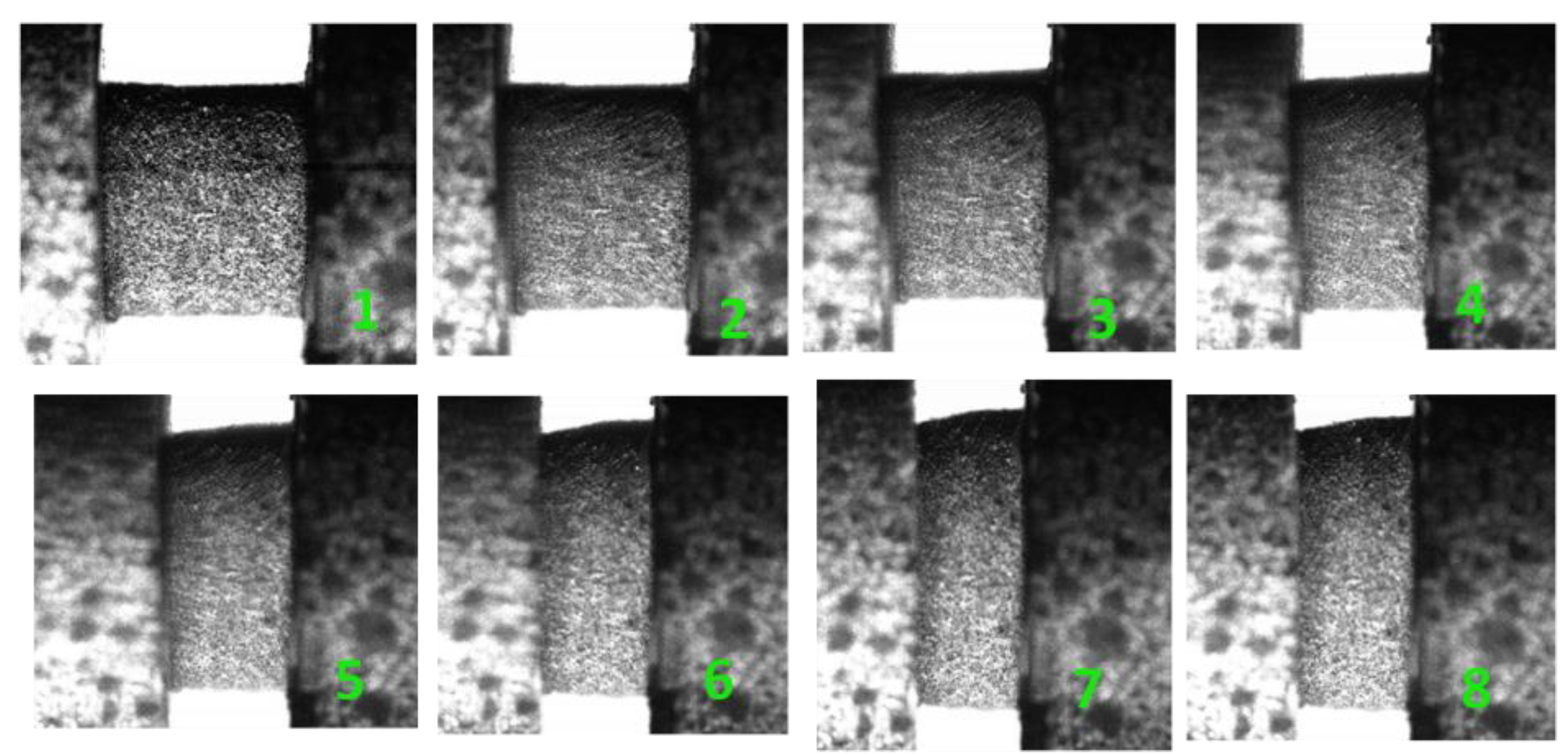
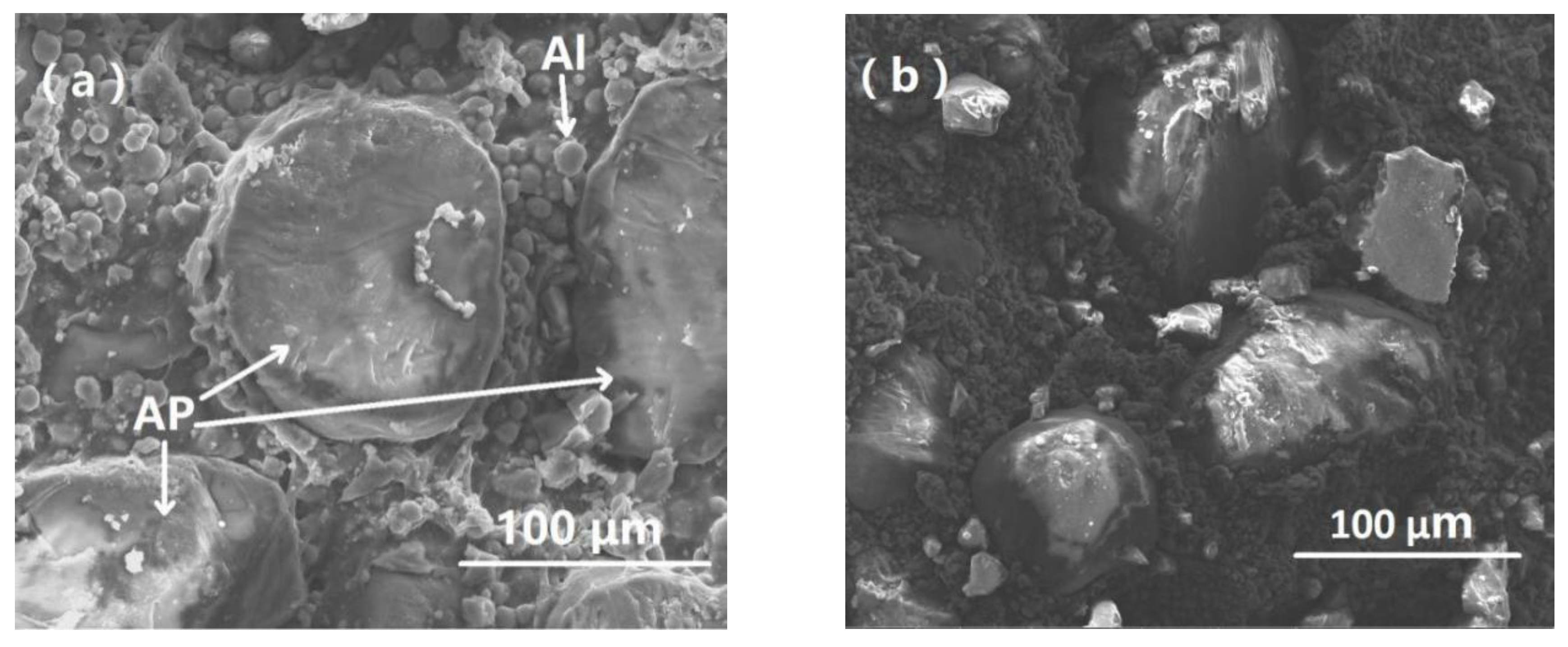

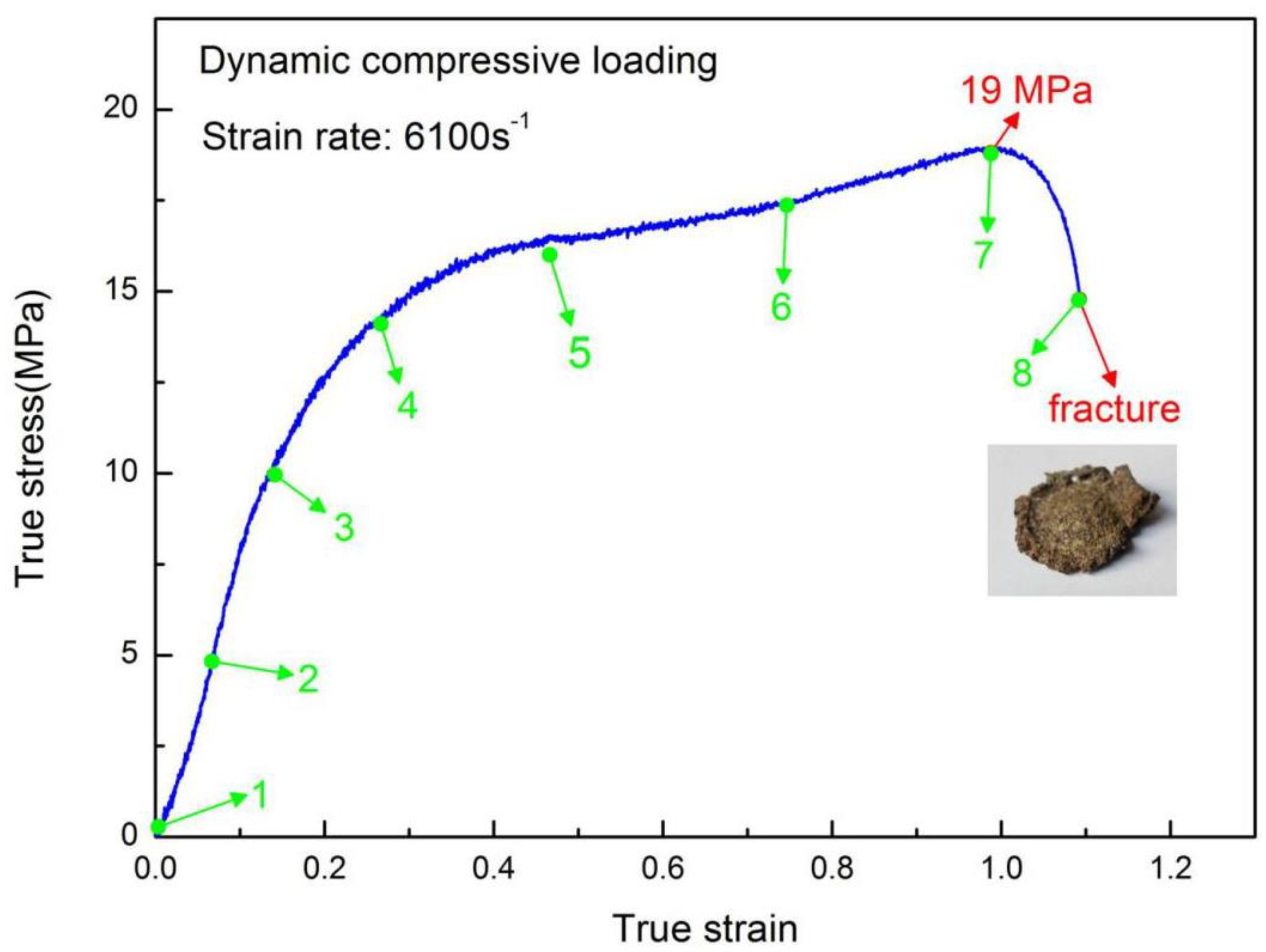
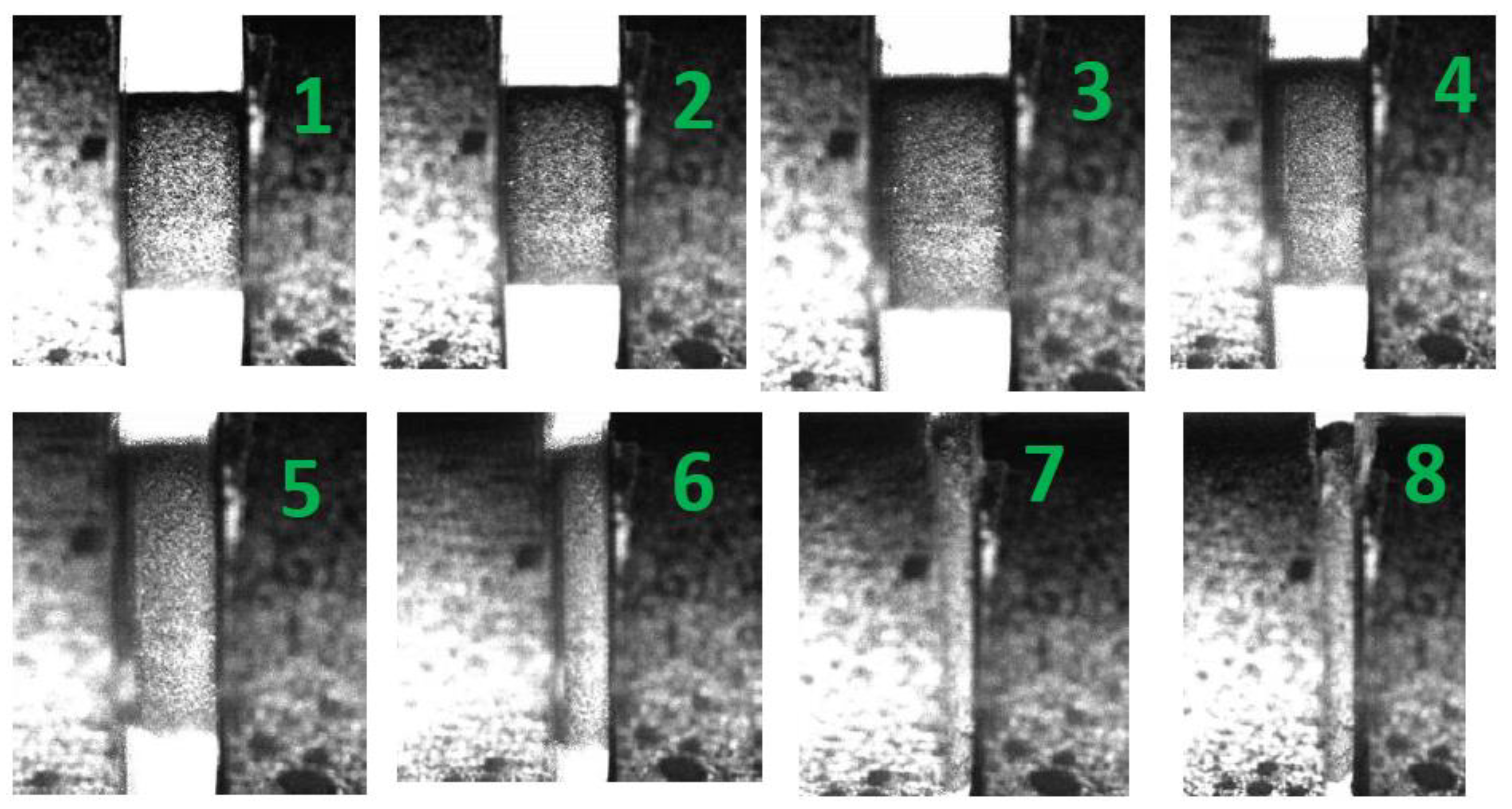
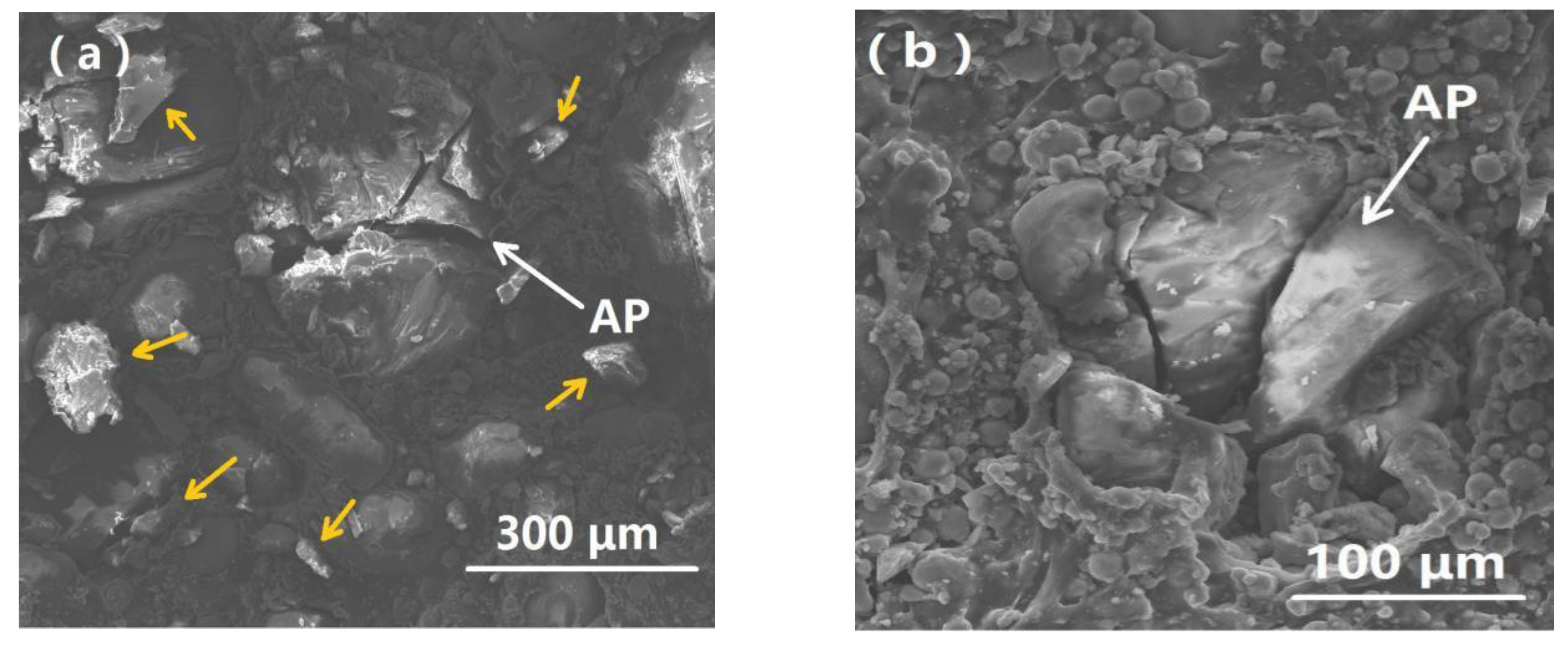
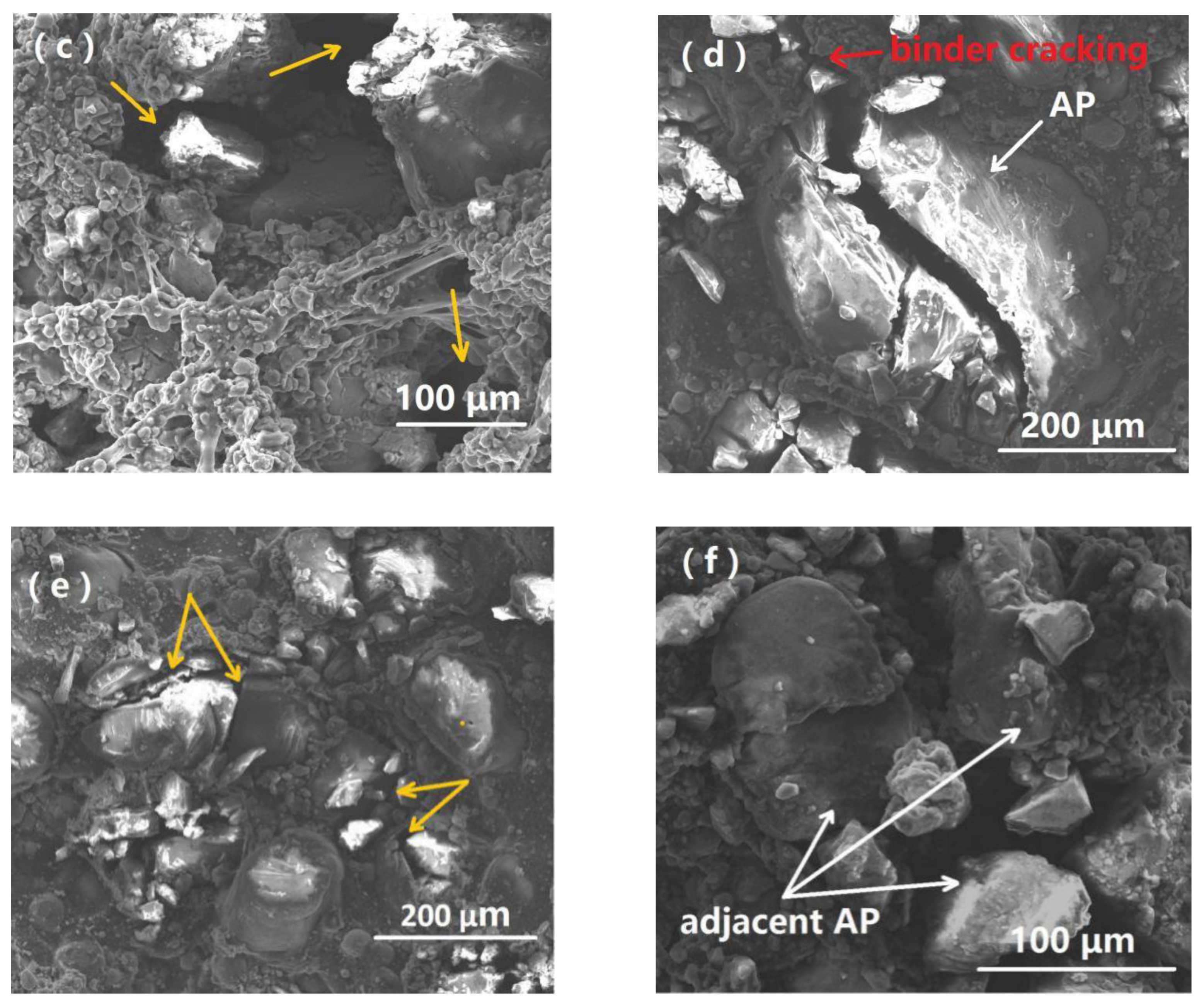
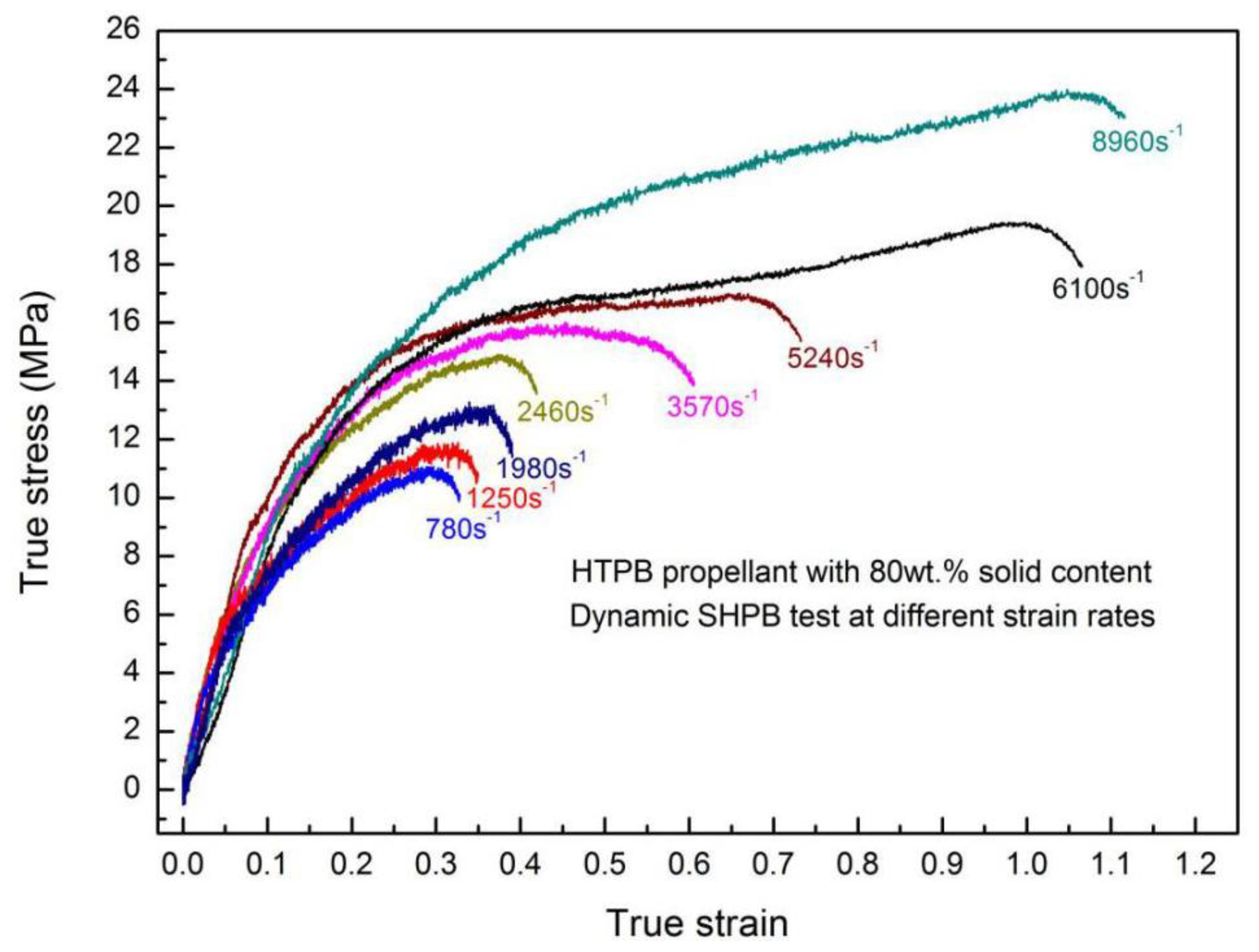


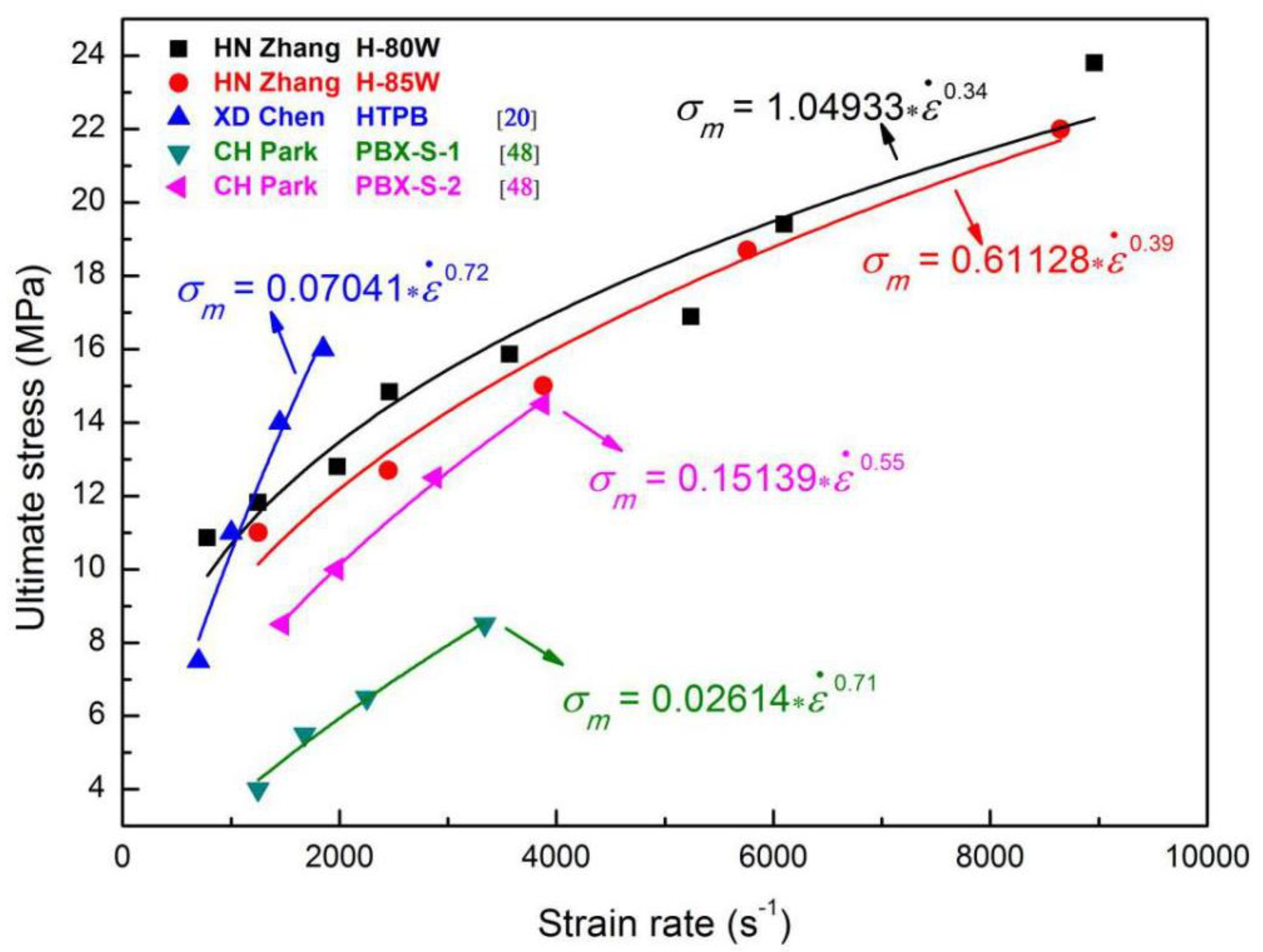
| Formulation | HTPB | AP | Al | DOA | Other Additives |
|---|---|---|---|---|---|
| H-80W | 12 | 65 | 15 | 4 | 4 |
| H-85W | 9 | 70 | 15 | 3 | 3 |
| Sample | Ultimate Stress | Strain Energy Density (U) | ||
|---|---|---|---|---|
| Kσ | m | Ku | m | |
| H-80W | 1.04933 | 0.34 | 0.00135 | 1.06 |
| H-85W | 0.61128 | 0.39 | 0.00015 | 1.30 |
© 2020 by the authors. Licensee MDPI, Basel, Switzerland. This article is an open access article distributed under the terms and conditions of the Creative Commons Attribution (CC BY) license (http://creativecommons.org/licenses/by/4.0/).
Share and Cite
Zhang, H.; Liu, M.; Miao, Y.; Wang, H.; Chen, T.; Fan, X.; Chang, H. Dynamic Mechanical Response and Damage Mechanism of HTPB Propellant under Impact Loading. Materials 2020, 13, 3031. https://doi.org/10.3390/ma13133031
Zhang H, Liu M, Miao Y, Wang H, Chen T, Fan X, Chang H. Dynamic Mechanical Response and Damage Mechanism of HTPB Propellant under Impact Loading. Materials. 2020; 13(13):3031. https://doi.org/10.3390/ma13133031
Chicago/Turabian StyleZhang, Hengning, Meng Liu, Yinggang Miao, Han Wang, Tao Chen, Xuezhong Fan, and Hai Chang. 2020. "Dynamic Mechanical Response and Damage Mechanism of HTPB Propellant under Impact Loading" Materials 13, no. 13: 3031. https://doi.org/10.3390/ma13133031
APA StyleZhang, H., Liu, M., Miao, Y., Wang, H., Chen, T., Fan, X., & Chang, H. (2020). Dynamic Mechanical Response and Damage Mechanism of HTPB Propellant under Impact Loading. Materials, 13(13), 3031. https://doi.org/10.3390/ma13133031





